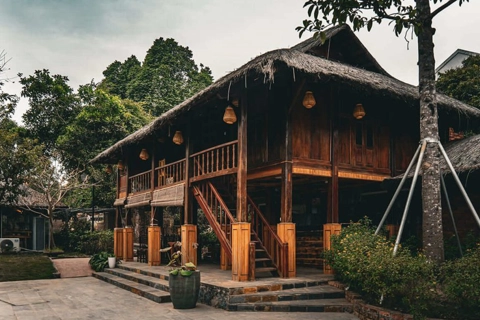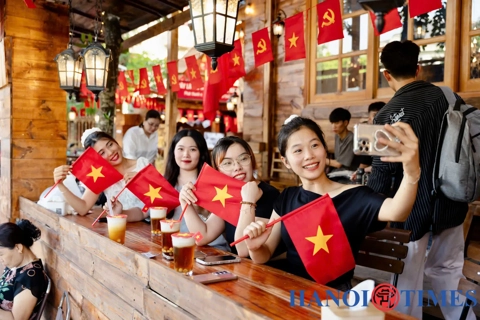Vietnamese enterprises anticipate ASEAN common visa policy
The six-nation visa initiative can help international tourists travel with ease throughout the ASEAN region.
Vietnamese businesses are expecting a new move - it's a common visa zone that allows foreign visitors to enter all six Southeast Asian countries: Vietnam, Cambodia, Laos, Malaysia, and Myanmar with a single visa application.
Enhancing appeal for tourists
| A group of international travelers at Lady Mu Pagoda in Hoian Ancient Town. Photo: Nguyen Anh |
As analyzed by tourism experts, Thailand's six-nation visa initiative is a good opportunity for Vietnam's tourism industry to increase international arrivals and overall competitiveness. However, there is a need for self-improvement in the industry to be able to take advantage of this initiative.
From the perspective of a travel agency specializing in inbound tourism, Viet Media Travel Corp General Director Pham Phuong Anh attributed European tourism's success to the Schengen visa policy, which allows tourists to move freely among 27 countries. Similarly, a common visa policy adopted by six ASEAN countries will provide Vietnam’s tourism sector with ample opportunities to draw international visitors.
Accordingly, a foreign traveler can enter any of the sextet with a visa issued by one of them. This is expected to help make these countries more attractive to tourists from distant markets such as Europe, Australia, or the US. In addition, it will provide an extra level of convenience for those who are planning long trips that involve several countries in Southeast Asia.
| The lanterns in Hoi An Ancient Town. Photo: Nguyen Anh |
Phuong Anh said Vietnam is likely to welcome many "common visa area" tourists or serve as their final leg in their Southeast Asian tour, thanks to its advantage of having 10 international airports and a wide flight network throughout the country. As for tourism enterprises, plans should be made to refresh current products, develop new tours with appropriate itineraries, and seek cooperation in promoting tourism specialties.
"If this policy is approved, it's necessary that the tourism sector quickly adopt policies to guide and support tour operators, restaurants, and hotels to embrace this opportunity," she suggested.
Nguyen Minh Man, Director of Marketing and Communications at TST Tourist, predicted that the joint visa scheme would create favorable conditions for Vietnam to connect with the region and other countries. This connectivity trend is growing rapidly around the world. It would also help Vietnam overcome difficulties in reaching international travelers due to restrictions in its own visa policy.
| Bat Trang Ceramic Village. Photo: Bat Trang Ceramics Museum |
Meanwhile, Nguyen Tran Hoang Phuong, Acting Director of the Institute for Social Tourism Research, said that Vietnam has many advantages, such as its location at the heart of the region and its status as one of the "canteens of Asian tourism". In addition, Vietnam has a large network of seaports and destinations with diverse cultural and natural attractions that captivate foreign visitors. In addition, tourists can travel by road, rail, or water to Vietnam or from Vietnam to its neighboring countries. Therefore, the common visa regime will serve as a powerful lever for Vietnam's tourism development.
Stepping up technology application
According to Duong Duc Minh, Deputy Director of the Ho Chi Minh City Research Institute for Tourism and Economic Development, the common visa policy, once introduced, will enhance the region's competitiveness while creating transnational tours and routes in Southeast Asia. As a result, Vietnam and other countries could welcome a new influx of visitors with longer stays and higher spending, while travelers would enjoy seamless mobility.
| Vietnam is a hospitable country for international tourists, but quality tourism products are still needed to retain them. Photo: Amanda Clarke |
In addition, the common visa policy will also improve the cohesion of the Southeast Asian community in terms of policy and strategy, thereby raising the regional status internationally.
Finally, it will not only help increase connectivity between Vietnamese localities but also allow multinational companies to operate tours and routes in a more effective manner.
"These require the synchronization of Vietnam's tourism data with those of the other five countries," Minh said.
Meanwhile, Vietnamese companies must first design inbound tours with itineraries from Vietnam to neighboring countries such as Laos or Cambodia. Therefore, the initiative will help remove barriers and facilitate the development of cross-border tours.
| Foreign visitors to Ponagar Tower in the central coastal city of Nha Trang. Photo: David Nguyen |
Statistics showed that in 2023, the ASEAN sextet received 70 million foreign visits, if the new visa agreement is reached, Vietnam's tourism industry will have a "bumper crop" of inbound visitors from the influx.
On the other hand, Vietnam has been trying to lure tourists from far-flung origins such as Europe, Australia, or the US, but has yet to capitalize on the large number of tourists from these markets traveling to neighboring Asian countries. That's why the initiative promises an opportunity to tap into the existing tourist base.
The Vietnamese Ministry of Public Security reported that if Vietnam and other countries sign relevant international treaties or agreements on common visas, their citizens should be allowed to use ID cards instead of current travel documents such as passports in each other's territory.
According to Vietnam's National Assembly, ASEAN countries are striving to unify documents. Accordingly, they are seeking an intra-bloc free movement agreement similar to that of the European Community. This means that Vietnamese citizens will be able to use ID cards to travel within the ASEAN region if the countries agree.

.jpg)














